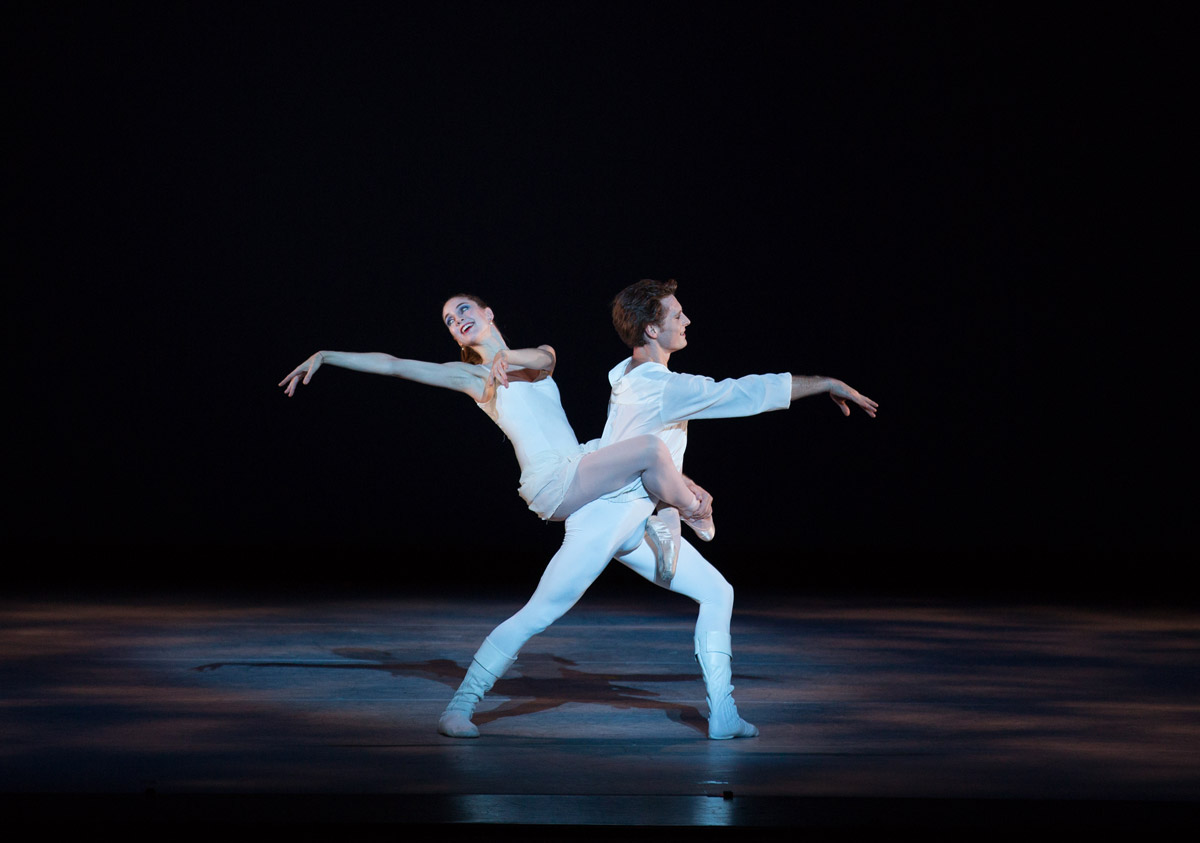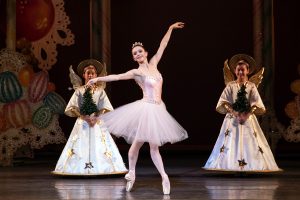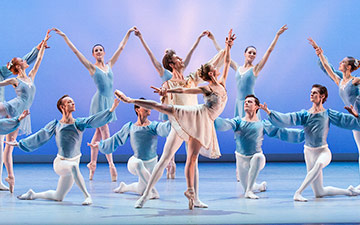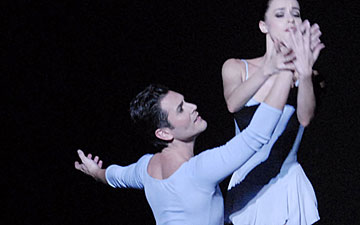
© Rosalie O’Connor. (Click image for larger version)
Suzanne Farrell Ballet
Walpurgisnacht Ballet, Act II pas de deux from A Midsummer Night’s Dream, Scène d’amour from Romeo and Juliet, Emeralds
Washington, Kennedy Center Opera House
30, 31 (mat) Octtover 2015
Interview with Suzanne Farrell (Oct 2015)
Company Website
www.kennedy-center.org
The Suzanne Farrell Ballet’s new program, “Balanchine, Béjart, and the Bard,” presented at the Kennedy Center Opera House at the end of October, was dedicated to the 400th anniversary of Shakespeare’s death. It offered an appealing mix of four ballets: the company’s premiers of George Balanchine’s Walpurgisnacht Ballet and Emeralds and duets from Balanchine’s A Midsummer Night’s Dream and Maurice Béjart’s Romeo and Juliet.
A sweeping evocation of Charles Gounod’s dance music from “Faust,” Walpurgisnacht Ballet was a particular treat for Washington’s ballet-goers. It’s a rarely performed ballet, and many in the audience (myself included) were able to see it in live performance for the first time. This is one of the most treasured aspects of this company – Farrell consistently includes in the repertory of her troupe not only Balanchine’s well-established masterpieces but his less frequently performed works as well.

© Rosalie O’Connor. (Click image for larger version)
The Walpurgisnacht scene from Gounod’s famous opera is usually associated with a bacchanalia of witches and satyrs. In his ballet, however, Balanchine was guided solely by the music. He responded to the score’s lighthearted, lucid charms by creating a rich, continuous flow of alluring and unpredictable movement with elaborate patterns – lines, circles, diamonds and flowers – which appeared and dissolved with a kaleidoscopic rapidity. At one point, 22 members of the all-female corps de ballet, dressed in light-purple shimmering gowns, their long hair flowing behind them, turned the stage into a breathtaking lavender field, which later became a stormy sea when the dancers, with spirited abandon, embraced the vigorous, high-kicking fervor of the choreography.
When Balanchine created this ballet in 1980, he specifically made the leading ballerina role for Farrell, who frequently performed it for many years afterward. She was extraordinary in it. “Playful, delicately mad and phrased with stunning but tasteful daring, it was a definitive Farrell performance that brought the house down,” raved the New York Times about her dancing in 1984.
Unfortunately, soloist Violeta Angelova, who danced Farrell’s role on opening night, didn’t possess the stylistic assurance and prima ballerina technique this part requires. She was lovely, spirited and endlessly delightful, but these qualities alone weren’t enough to give the choreography its full measure, and that sense of daring that Farrell so famously brought to her roles was also missing in Angelova’s performance. She was partnered by Ted Seymour, a capable but unassuming dancer.

© Rosalie O’Connor. (Click image for larger version)
Yet Angelova was a revelation as Juliet in Scene d’amour from Romeo and Juliet on the following day, dancing with Kirk Henning. She reveled in Béjart’s highly-skewed classical idiom, turning this brief pas de deux into a piece of emotionally-charged theater. It felt as if she let her guard down, giving us a wide-eyed Juliet intoxicated and giddy with love. Dancing under the ominous full moon, Angelova and Henning not only effortlessly sailed through every tricky lift and hold of this highly acrobatic dance, but they also managed to nail all dramatic accents of their characters amorous relationship: the ecstasy, anguish and impending doom.
On opening night, Henning was a wonderfully assertive and elegant cavalier in the Act II pas de deux from A Midsummer Night’s Dream, partnering Heather Ogden with superb skill and gallantry. In his gentle yet assured embraces, Ogden, a ballerina of exceptional beauty and artistry, moved about the stage as if floating on air, gently unearthing the hushed and exquisite atmosphere of the dance. This duet is a quiet and tender piece – a striking anomaly in a ballet that brims with wild action and improbable adventures of the main characters. It’s as if Balanchine decided in the middle of his Midsummer to let everyone on the stage and in the theater to take a breather to peacefully reflect on their lives and love. Here the choreography gorgeously echoes Mendelssohn’s lush, tranquil melodies. “It’s as if they’re dancing on clouds, and the couple remains in physical contact nearly the entire time. Perhaps this was Balanchine evoking a perfect union, what a marriage ideally should be,” wrote Farrell in the program notes.

© Rosalie O’Connor. (Click image for larger version)
The evening concluded, most memorably, with Emeralds, the opening section of Jewels. “I believe seeing Emeralds at the end of the program instead of at the beginning will allow those who are familiar with this ballet to perceive it in a different, powerful way,” said Farrell in her recent interview with DanceTabs when she described the company’s new season. Indeed Emeralds, in Farrell’s insightful staging, made for a highly effective curtain-closer.
Ogden was mesmerizing in the first ballerina role. Dancing with regal poise, she maintained an air of mystery as she drifted hand-in-hand with her noble cavalier, the excellent Thomas Garrett, in his first season with the company. Her liquid-arm solo was both tantalizingly playful and delicate; and the feeling of love that she projected so vividly during her duets with Garrett made these Emeralds sparkle with an entirely new light.

© Rosalie O’Connor. (Click image for larger version)
Natalia Magnicaballi brought quiet glamour and a bit of nostalgia to the role of the second ballerina. (Magnicaballi was also a poignant Juliet, unspooling with fervent zest her heroine’s tempestuous feelings in the pas de deux with Michael Cook.) Allynne Noelle, Jordyn Richter and Ian Grosh shone in the sprightly pas de trois, giving a splash of vigor to the fluid melancholy of the ballet. The corps de ballet was in good form, etching each movement cleanly and assuredly. Putting the cherry on the top, the Opera House orchestra was simply marvelous as Scott Speck led the musicians in a delicately dreamy account of Faure.

















You must be logged in to post a comment.